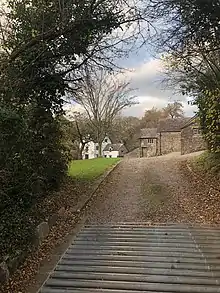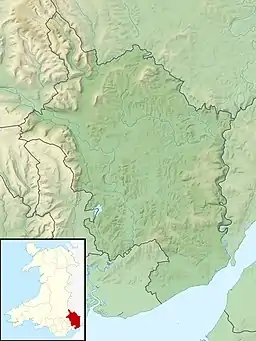Nantybanw, Llantrisant
Nantybanw, Llantrisant, Monmouthshire is a country house dating from 1625. The house is Grade II* listed and the associated farm buildings have their own Grade II listings.
| Nantybanw | |
|---|---|
 "An important early 17th century house" | |
| Type | House |
| Location | Llantrisant, Monmouthshire |
| Coordinates | 51.6709°N 2.8585°W |
| Built | 1625 |
| Architectural style(s) | Vernacular |
| Governing body | Privately owned |
Listed Building – Grade II* | |
| Official name | Nantybanw |
| Designated | 4 March 1952 |
| Reference no. | 2716 |
Listed Building – Grade II | |
| Official name | Barn range at Nantybanw |
| Designated | 22 June 2000 |
| Reference no. | 23500 |
Listed Building – Grade II | |
| Official name | Cider House at Nantybanw |
| Designated | 22 June 2000 |
| Reference no. | 23501 |
Listed Building – Grade II | |
| Official name | Mill house at Nantybanw |
| Designated | 22 June 2000 |
| Reference no. | 23502 |
 Location of Nantybanw in Monmouthshire | |
History
Nantybanw has a datestone of 1625[1] and was long-thought to have been constructed entirely in that mid-17th century period. Recent research shows a more confused genesis. RCAHMW suggests that a reconstruction c.1600 of an earlier house, was continued by the addition of extensions dating from 1625.[2] The house was reconstructed in the 19th century and fully restored in the 20th. This restoration saw the inclusion of doors and doorcases from a demolished house, Graig Olway, Llangeview, and the insertion of a new staircase modelled on that at Upper Dyffryn House, Grosmont.[1] Nantybanw remains a private residence.
Architecture and description
The house is of two storeys, with attics, and is constructed to a T-plan. It is built of whitewashed rubble.[2] The architectural historian John Newman, notes the "typical but not especially rich timber fittings" of the interior.[1] Peter Smith records the house as possessing examples of the "typical Welsh ornate doorheads" in his work Houses of the Welsh Countryside.[3] The house is listed Grade II*, its listing record describing it as "an important early 17th century house (with a) great deal of surviving original detail".[2] The associated barn range,[4] cider barn[5] and mill house have their own, Grade II, listings.[6]
Notes
- Newman 2000, p. 359.
- Cadw. "Nantybanw (Grade II*) (2716)". National Historic Assets of Wales. Retrieved 14 April 2019.
- Smith 1988, p. 505.
- Cadw. "Nantybanw barn range (Grade II) (23500)". National Historic Assets of Wales. Retrieved 14 April 2019.
- Cadw. "Nantybanw cider house (Grade II) (23501)". National Historic Assets of Wales. Retrieved 14 April 2019.
- Cadw. "Nantybanw mill house (Grade II) (23502)". National Historic Assets of Wales. Retrieved 14 April 2019.
References
- Newman, John (2000). Gwent/Monmouthshire. The Buildings of Wales. London: Penguin. ISBN 0-14-071053-1.
- Smith, Peter (1988). Houses of the Welsh Countryside. London: Her Majesty's Stationery Office. ISBN 9-78011-300012-8.